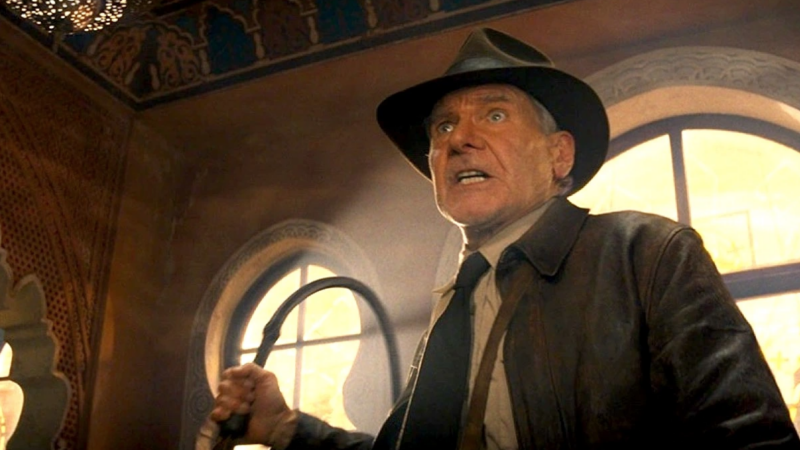Indiana Jones and the Dial of Destiny Is a Dud
It might as well have been titled Indiana Jones and the Quest for Cash.

Quick: Name your favorite bit from an Indiana Jones film. I mean "bit" expansively—it could be a quip, an extended action sequence, a scene of tension or tenderness, a shocking effect, a moment of playfully mischievous charm. One could say that the series, at its best, is marked by a profusion of these moments, but perhaps even more important is that the series is marked by them even at its worst.
Raiders of the Lost Ark, which kicked off the franchise in 1981, is a masterpiece of popular filmmaking, in which every single scene, shot, and line works individually, and somehow they all work even better together. Raiders created a magic movie alchemy that still maintains an outsize influence on blockbuster movies more than 40 years later.
Indiana Jones and the Temple of Doom, the second film in the series, is far worse than its practically perfect predecessor: It's both too silly and too grotesque, too mean-spirited and too enamored with its own elaborate action-movie cleverness. But it also boasts a slew of ideas and images that you can instantly recall: the antic diamond scramble in the nightclub that kicks off the movie, the gross-out meal at the palace, the mine-cart chase, the shocking, gory, ritual heart removal scene.
The same can even be said for the franchise's much-derided, late-breaking fourth entry, Indiana Jones and the Kingdom of the Crystal Skull, which contains a handful of crackerjack, high-hijinks action sequences and a delightfully ridiculous performance from Cate Blanchett, as the Natasha-esque villain. You may not care for the movie, or remember all the specifics, but you still know what it means to "nuke the fridge."
All four of these films, of course, were directed by Steven Spielberg, whose gift for witty comic action is unrivaled in modern Hollywood. Spielberg's action sequences may not make total sense in terms of real-world physics, but they all have perfectly coherent internal logic—even if it's Looney Tunes logic.
And they were anchored on maximally charming Harrison Ford performances in his movie star prime (or, in the case of Crystal Skull, only a little past it). If you want to understand what it means to be a movie star, watch Ford in these films: Not only does he take patently ridiculous material and make it a hoot, he makes a roguish, bordering-on-unlikable jerk—Indy is selfish and buffoonish throughout the series—and turns him into one of cinema's most enduringly charming characters.
Sadly, the same can't be said for the newest installment in the franchise, Indiana Jones and the Dial of Destiny. The fifth installment is a charmless dud, with no apparent reason to exist other than the enduring appeal of the character. It might as well have been titled Indiana Jones and the Quest for Cash.
Instead of Steven Spielberg, the film is directed by James Mangold, who conspicuously lacks Spielberg's gift for antic action. The big setpieces are creaky and uncreative, with none of the cartoon logic that gave Spielberg's over-the-top setpieces such energy and life. Several sequences, including an opening fight on top of a train and a chase that has Indy riding a horse into a subway, are so riddled with awful computer-generated effects work that at times they almost look fully animated. Almost every shot in the movie looks like it was shot inside, in front of a green screen, with heavy compositing work in post-production. For a series about global adventure, it rarely looks like Indy actually goes anywhere beyond the studio backlot.
And while it brings back Ford as the lovably grumpy archaeologist of the title, it also pairs him with Phoebe Waller-Bridge, playing Indy's goddaughter, another roguish archaeologist with some self-dealing tendencies, Helena Shaw. Anyone who's seen Waller-Bridge's Fleabag knows she has a gift for making nominally unlikable characters vulnerable and charming, and you can imagine her capturing some of the young Ford's roguish appeal. Instead, she's just blandly off-putting, as if the filmmakers forgot to put the charming bits in.
The script, meanwhile, goes from boring to bizarre, with a third-act twist that feels like it came from a Roger Corman quickie.
A late-breaking sequel with an aging star need not be a disaster: Just a few years ago, Harrison Ford reprised his 1980s role as the robot-hunting detective Rick Deckard in the remarkable, haunting Blade Runner 2049.
But Indiana Jones and the Dial of Destiny mostly just serves as a reminder of how great even not-so-good Spielberg/Ford joints used to be. There's not a memorable bit or moment in the movie, not a scene or a line or a gag that will stick with you for the rest of your life. The franchise's 1980s installments are some of Hollywood's most prized relics; but these days, Indiana Jones just belongs in a museum.



Show Comments (57)